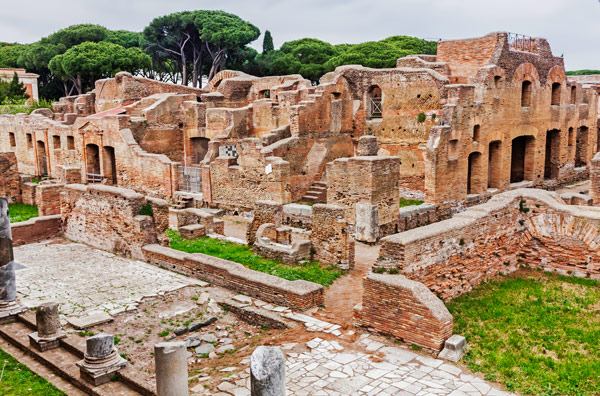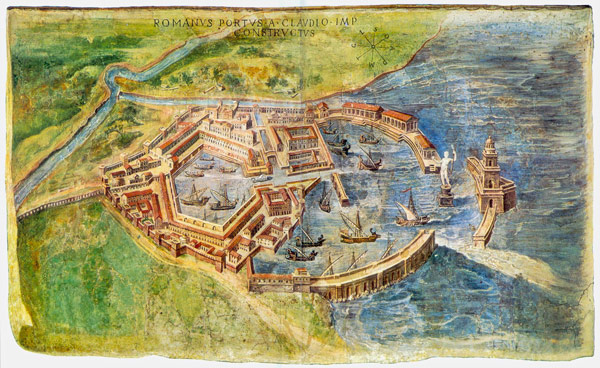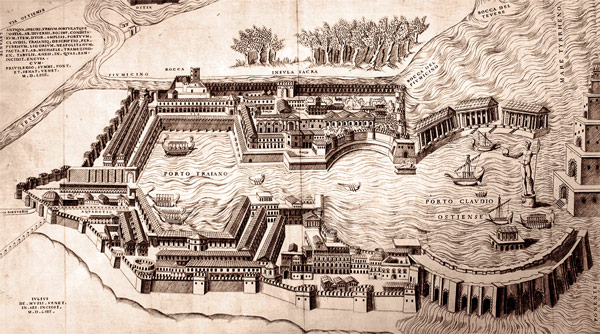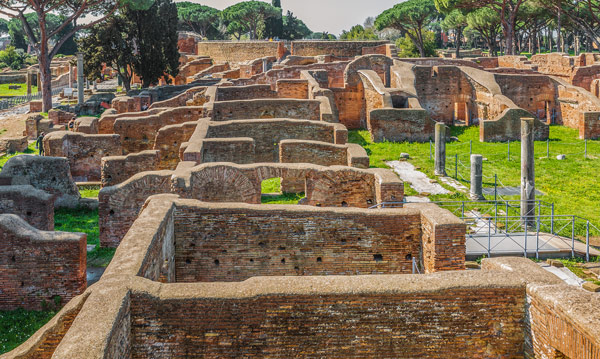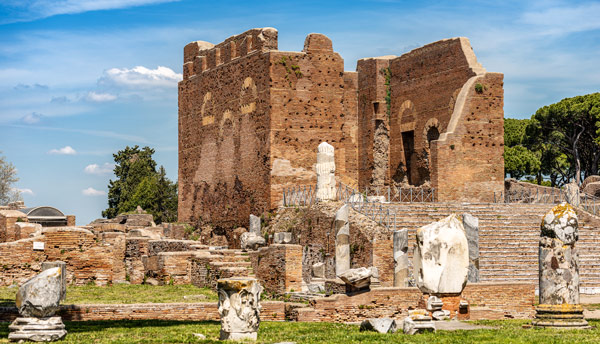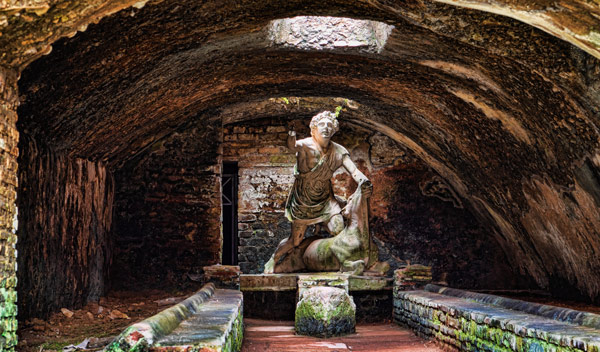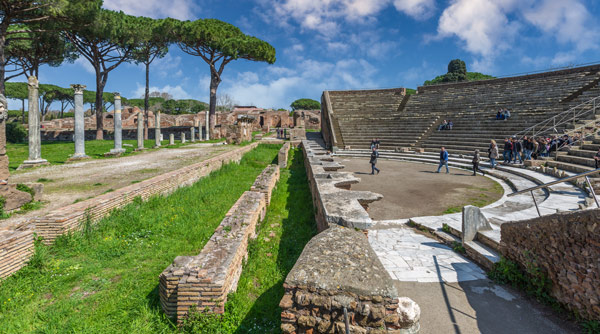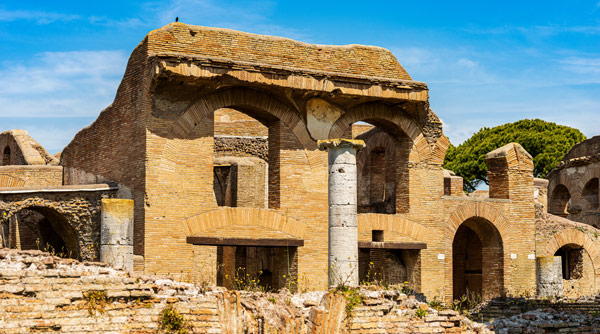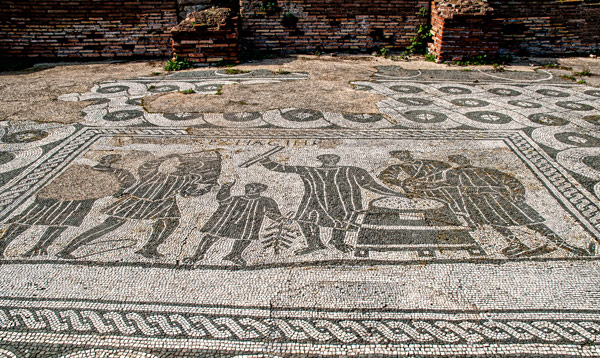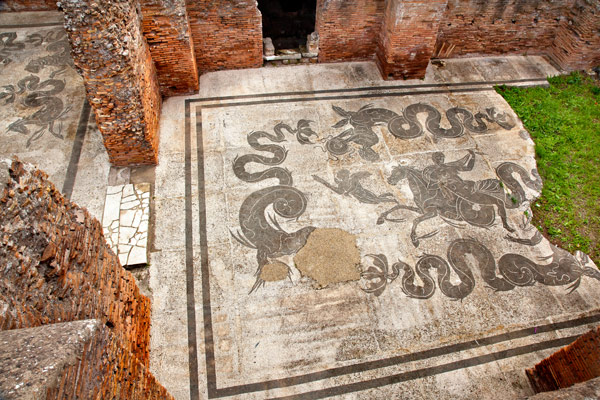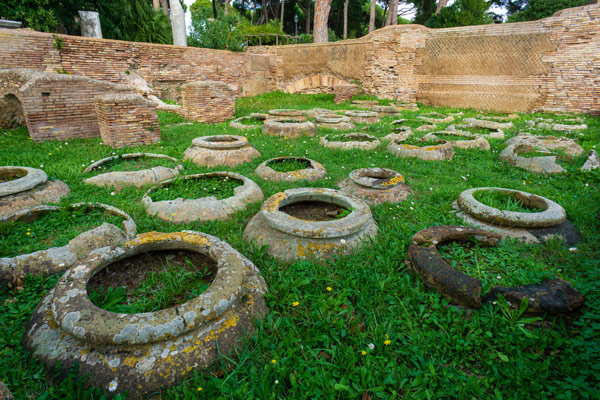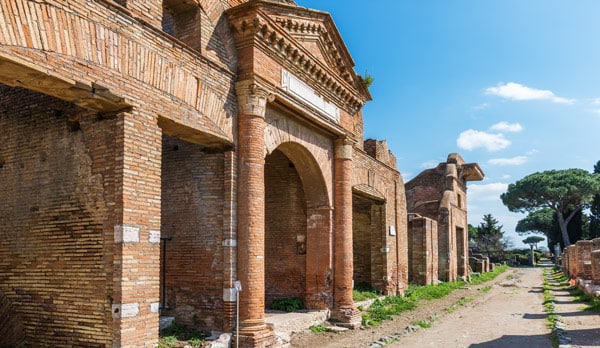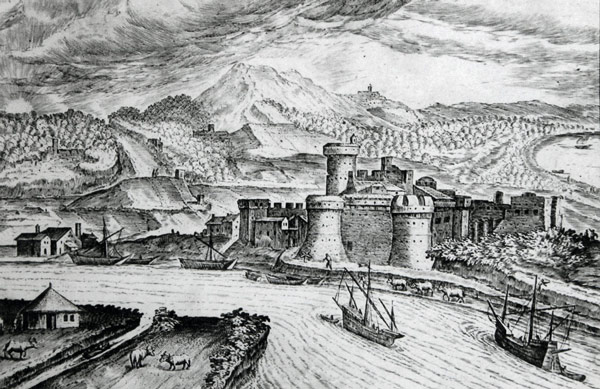Ostia Antica – an ancient Roman port city, now one of the most significant archaeological reserves with well-preserved attractions: streets and buildings, magnificent frescoes, and mosaics.
Situated approximately 15.5 miles (25 km) southwest of modern-day Italy’s capital, it serves as the thirty-fifth district of Rome, known as Z. XXXV.
It’s hard to believe, but once Ostia was washed by the waves of the Tyrrhenian Sea, which has gradually receded by about 1.9 miles (3 km), leading to the decline of this coastal city.
Despite all roads of the vast empire leading to Rome, the role of Ostia as a port and trading center cannot be overstated. This ancient metropolis existed and thrived thanks to efficient supply chains and the development of sea routes.
Page Contents
Name and Foundation
Archaeological excavations suggest that the earliest preserved buildings in Ostia date back to the 4th century BC. Among the most ancient is a castrum—a military camp with fortress walls built to protect Rome from enemy invasions via the river from the sea.
The area of the castrum was about 635 x 412 feet (194 x 125.7 meters), and the walls, made of tufa blocks, were at least 4.9 feet (1.5 meters) thick. Two perpendicular streets, cardo and decumanus, connected the four gates of the fortress and defined the future layout of Ostia.
Gradually, as the maritime military threat waned, residential and commercial quarters formed around the castrum, turning it from a Roman legionnaire’s deployment site into a significant harbor and commercial center.
The Main Port of Ancient Rome
As a port and commercial center, Ostia developed concurrently with Rome’s flourishing.
Port of Ostia
The primary commodity supplied to the empire’s capital was grain from Sardinia (Sardegna) and Sicily (Sicilia), and later from Egypt. The number of ships delivering wheat to the Port of Ostia numbered in the hundreds. This strategically vital product served as a tool in the hands of emperors and defined state policy, regulating the so-called grain laws (leges frumentariae).
The people of Rome demanded “bread and circuses” and received them in full measure from their rulers, who thereby gained popularity and favor among the masses.
Initially, Ostia was more of a river port, where large vessels could not dock.
Frequent siltation of the riverbed with sand and the silting of waters required constant and costly dredging to deepen the mooring areas for ships. Moreover, the boundaries of the sea gradually receded, and combating this natural phenomenon was impossible.
Port of Claudius
In 42 AD, under Emperor Claudius (Tiberius Claudius Caesar Augustus Germanicus), construction began on a new artificial harbor 2.5 miles (4 km) north of Ostia, as the old Port of Ostia could no longer handle the large grain shipments from Egypt.
An idea of what the ancient Port of Ostia might have looked like can be seen in a reconstruction done by Ignazio Danti in 1582, which is today displayed in the Gallery of Maps at the Vatican Museums (Musei Vaticani).
The new coastal city was named Port (Portus) or Portus Augusti. Its harbor covered 494 acres (200 hectares) and featured two breakwaters (wind protection structures) and a tall lighthouse, similar to the famous Lighthouse of Alexandria. The water body was connected to the Tiber by two canals, which created the artificial island of Isola Sacra between Ostia and Portus, which literally means “sacred island.”
The construction works were completed in 64 AD during the reign of Nero (Nero Claudius Caesar Augustus Germanicus), and a little earlier, in 62 AD, a tragedy occurred – during a severe storm in the new harbor, 200 ships sank.
Trajan’s Port
After coming to power, Trajan (Marcus Ulpius Nerva Traianus), during the period of 100–112 AD, expanded and improved the Port of Claudius, which became known as Portus Augusti Traian. Below is a reconstruction:
On the 2-kilometer-long quay, there were also shops, administrative buildings, and a three-story Imperial Palace, where essential guests could stay. The impressive structure of the new port allowed for the transshipping of goods from sea vessels to smaller boats and their delivery via the Tiber River directly to Rome.
In the 2nd century, Ostia remained, along with the Port, the main harbor of the empire, supplying Rome with grain, olive oil, wine, marble, lead, and many other goods. Meanwhile, Ostia’s functions increasingly became limited to administrative activities and serving as a place for workers who serviced the new port.
Urban Structure
Ostia’s flourishing and construction boom occurred from the first half of the 2nd century to the beginning of the 3rd century. It was associated with the improvement of the harbor and the development of trade.
In its best years, the population of Ostia reached up to 75,000 people and had the characteristic international composition of a port city.
The urban structure of Ostia was organized primarily considering its primary function as a port and trade center. It is known that Ostia was divided into districts and followed the standard plan of Roman cities of the 2nd century. There’s even a parallel to be drawn between the capital of the empire and Ostia – a more miniature copy of Rome.
Sacred Places
In ancient Ostia, the ruins of numerous religious buildings dedicated to various deities have been preserved.
On the southern side of the Forum, which was established at the center of the castrum, the Capitolium dedicated to the chief Roman gods Jupiter, Juno, and Minerva was built during the time of Hadrian (Publius Aelius Traianus Hadrianus) in 120 AD, and to the south – temples to the goddess Rome and Augustus.
The ruins of the Capitolium, erected on a high pedestal, are still clearly visible in the archaeological area of Ostia.
- It’s advisable to read about the Capitoline Hill in Rome.
Beyond the western gates of the castrum lies the sacred area of the ancient temple of Hercules, built in the last quarter of the 2nd or the first half of the 1st century BC. Here, a marble statue of the resting Cartilia Poplicola – one of the political figures of Ostia in the 1st century BC – was found.
Near the river port in the 1st century, a complex of four adjacent temples, identical in form and size and dedicated to the deities Venus, Fortuna, Ceres (goddess of harvest and fertility), and Spes (goddess of hope), was erected.
The Eastern deity Mithras (Mithras), associated with friendship, justice, and harmony, was held in special honor by the inhabitants of Ostia. There were 18 temples in the city dedicated to him, known as mithraea (mithraeum).
The Phrygian goddess of fertility, Cybele (Cybele), or the Great Mother, also had many followers. The sanctuary in her honor was the largest of the religious buildings of Ostia during the imperial era and occupied a vast triangular area, Campo della Magna Mater, between Cardine Massimo and the city’s edge wall.
The Theater
The theater in Ostia was built during the reign of Emperor Augustus, constructed by his son-in-law Agrippa between 18 and 12 BC.
This impressive building was located on the main street of Ostia, Decumanus Maximus, and after expansion at the end of the 2nd century, it could accommodate up to 4,000 spectators. Behind the theater’s facade were 16 shops, and two semi-circular twin nymphaea at the entrance on the sides.
In 216 AD, an arch in honor of Emperor Caracalla was erected in front of the theater, who also built the most oversized baths (Terme di Caracalla) in Rome.
The favorite entertainment venue of the residents of ancient Ostia lasted until the 4th century. Before the first excavations in 1880–1891, the theater site was a slope of earth and rubble. Today, the restored theater is one of the most visited sites in ancient Ostia.
It is again used for performances and festive shows, which can be viewed by about 2,700 spectators.
Homes
Homes in Ostia were available for the rich, middle, and poor classes and essentially replicated the ancient architecture of Rome.
At the townspeople’s and guests’ disposal were numerous shops, brothels, taverns, nymphaea, baths, and public toilets, which, incidentally, also served as a place for discussing news.
Insulae
An exciting feature of Ostia is the residential buildings known as insulae, a term which translates to “island.”
These brick and concrete multi-family buildings had up to 3-4 stories and housed about 12 families. Access to the upper levels was via an external staircase from the courtyard, while individual apartments (mainly consisting of 2 rooms) could be interconnected by corridors. Typically, the dwellings were rented to families or served as hotels.
More than 200 insulae have been excavated in Ostia, well-preserved in the silt layer of the Tiber, revealing beautiful mosaics and fresco fragments to the modern world.
About 90% of the ancient port’s population lived in these “high-rises,” with the wealthier citizens occupying the first level and the poor residing in the upper levels without amenities.
Insulae typically had their own inner courtyard with a cistern and tabernae (taberna) – large spaces on the first floor for commercial purposes. Here, food was prepared, bread was baked, trade was conducted, and even cults to various deities were practiced.
In Rome, to the right of the Altar of the Fatherland (Altare della Patria), are the remains of the Insula dell’Ara Coeli, dating back to the 2nd century AD. Be sure to take a look if you have the chance. Read more about the tabernae in my review of Taberna De’ Gracchi– a restaurant near the Vatican.
Domus
Alongside the insulae in Ostia, there were also luxurious homes called Domus. Typically, they had several rooms, an atrium, a pool, an inner courtyard, and rich decorations. Mosaics, sculptures, and inscriptions found in ruins gave names to such aristocratic homes in Ostia as the Domus dei Dioscuri (Domus of the Dioscuri), Domus di Amore e Psiche (Domus of Cupid and Psyche), Domus del Ninfeo (Domus of the Nymphaeum), Domus dei Pesci (Domus of the Fishes), and others.
In the territory of ancient Ostia, the House of Bacchus and Ariadne (1st century) is noteworthy, adorned with complex mosaics with vegetal motifs and an image of Bacchus and Ariadne watching the struggle between Eros and Pan, symbolizing love and sensual passion.
The most significant area of preserved floor mosaics and wall frescoes is the elite residence from Hadrian (130 AD) – the House of the Muses (Insula delle Muse). In its rooms, a beautifully preserved cycle of paintings of the nine muses and Apollo and magnificent mosaics with the most diverse motifs can be found.
The Baths
The public baths (thermae) of Ostia, numbering in the dozens, were equipped with complex water supply and heating systems and lavishly decorated with marble, mosaics, and sculptures.
Right on the Forum are the largest baths of Ostia — Terme del Foro. The bath sections appeared in the year 120 and were still in operation in the 5th century, as long as the city’s aqueduct supplied water.
The Sea Baths (Terme Marittime), built during the Hadrian period around 130 AD, represented a true resort. The structure, in the form of stone terraces descending directly to the sea, had several rooms, including those with cold baths and a heated pool.
The Terme Maritime existed in the 4th century, then was abandoned and repurposed as a lime processing site. Excavations revealed the remains of the architectural structure and magnificent mosaic floors depicting sea creatures, masks of the god of the ocean, and athletes.
- Read more about baths and aqueducts in Ancient Rome.
Another large ancient resort known for its structural remains and preserved decor is named after the sister of Emperor Trajan, Marciana, as her sculptural portrait was found there. The Baths of Marciana or Terme di Porta Marina (or della Marciana) were built around 110 AD in the style of a spa resort, with training rooms, changing rooms, pools, and baths. Today, in these baths, one can see incredible black and white mosaic panels with a maritime theme and fragments of sculptures.
The findings at the Baths of Mithras (Terme del Mitra) site, built during the Hadrian period (117–138 AD), are of interest. These include a cult statue discovered in an underground temple, “Mithras killing the bull,” marble decorations of the baths in medallions depicting noble persons, and a monochrome mosaic with figures of gods and mythological creatures.
Read about Ischia Thermal Baths.
Warehouses
Among the most important buildings in Ostia were the warehouses — horrea. They stored grain, wine, oil, and other supplies before they were shipped to Rome.
The largest, Grandi Horrea, built during Claudius’ reign, was located in the center of the city and was a vast rectangular complex with a series of storage rooms, each with a mezzanine floor.
It is presumed to have held state grain reserves that could provide bread for one year to 14-17 thousand people.
The well-preserved warehouse building in Ostia, Horrea Epagathiana et Epaphroditiana, belonged to the Greek freedmen Epagathus and Epaphroditus.
Built in 145-150 AD, adjacent to the ancient wall of the castrum, the three-story building had an inner courtyard with an entrance, a row of shops, a niche with a cult statue, and several separate storage spaces. The warehouse had a complex locking system, small windows, and thick walls for securely storing precious items. A mosaic depicting panthers is preserved in a section of the building’s inner courtyard.
Decline
In the 3rd century, Ostia definitively ceded its importance to the neighboring Port, which gradually became the center of Rome’s economic activity.
Another reason for the decline was the “Crisis of the Third Century,” when constant barbarian raids brought the economy and trade of the Roman Empire to its knees. The population of Ostia sharply decreased, partly due to the plague, which, over 20 years (250–270 AD), decimated 30% of the empire’s population.
In the early 4th century, there was some improvement in Ostia’s state and economy. Emperor Maxentius (Marco Aurelio Valerio Massenzio) established a new mint in the city, and Constantine I (Flavius Valerius Aurelius Constantinus) built a basilica dedicated to Saints Peter, Paul, and John the Baptist. The city still operated 26 baths, repaired old buildings, and erected new ones. Despite the cessation of port-related activities, Ostia remained a place of luxurious mansions.
During the 5th century, the population continued to decrease, exacerbated by the cessation of the aqueduct’s operation. Ostia was finally abandoned by its citizens in 846 AD, following its plundering by Saracen pirates.
For the safe living of the remaining population, the fortified town of Gregoriopolis (Gregoriopoli) was built to the east of Ostia in the 9th century by order of Pope Gregory IV (Gregorius PP. IV).
In the Middle Ages, abandoned Ostia became a source of marble, which was reused for building structures in Gregoriopolis.
Tickets and Opening Hours
Ostia’s archaeological area is open for daily visits from 08:30 to 16:30, except on national holidays (January 1, May 1, and December 25-26). From April 1 to September 30, there is an extended schedule until 19:00. The last admission is one hour before closing.
Ticket price: 12 euros for citizens of the European Union aged 18 to 25 years – 2 euros, children under 18 – free.
Guided Tours
Ostia Antica is a unique architectural monument, comparable only to Pompeii (Pompei). Few cities in the world have preserved their structure from ancient times almost unchanged. The ancient port of Rome covers an area of about 150 hectares (370 acres), while only 40% of it has been excavated to date. New and unique discoveries are still waiting to be made.
 Italy for me From Italy with love
Italy for me From Italy with love


